In the sixth ayah of Surah Hud, Allah states that Allah gives the "sustenance" of all living things, that is, Allah creates all the provisions that provide for their subsistence:
There is no creature on the earth which is not dependent upon Allah for its provision. He knows where it lives and where it dies. They are all in a Clear Book. (Surah Hud: 6)
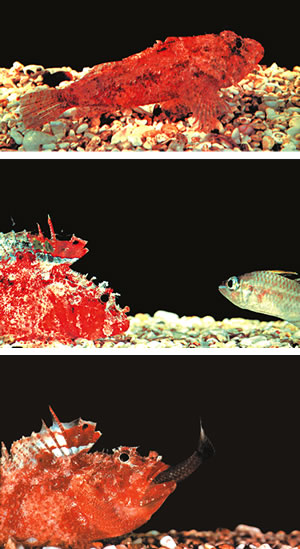 |
| 1.The closed fin. |
One can easily recognise how Allah "gives sustenance" to all living things once one looks around oneself conscientiously and with wisdom. All our food and drink are things that are "made" and "created". The water we drink, the bread, fruits and vegetables we eat are all the results of a special creation. Take a fruit, an orange for instance.... This fruit is originally formed on the branch of a tree, which is, in fact, a mass of wood. The tree absorbs minerals and water from the soil and combines them with the energy it obtains from the sun. The result it yields is extremely useful for the human body, extremely tasty and fragrant when consumed by humans. Moreover, it is in a very healthy and aesthetically pleasing wrapping.
How does a tree bring about such a yield? Why is it so useful to the human body? Why do all fruits contain essential vitamins appropriate to the seasons in which they grow? Why are they so tasty and not bitter? Why are they so fragrant and do not stink?
Certainly a tree is just a bulk of wood and it is out of the question for it to produce a fruit on its own and equip it with features essential for human use. Just as Allah sustains human beings, so does He sustain the animals. In the following pages, we will review the hunting techniques some living beings use to reach their sustenance.
It is by no means difficult for one to understand the might and omnipotence of Allah if one conscientiously examines, within the boundaries of wisdom and logic, the systems with which animals are endowed to get their food. Every animal that we cover in this chapter is one of the great examples Allah has spread out on the earth.
For instance, the "hunting technique" of the fish you see on the next page is amazing. This fish neither chases its enemy nor does it lurk secretly to dash upon them. The fish is no different from others at first glance. Yet, as soon as it lifts its fin, a "fake fish" appears on its back. When other fish approach this small fake fish, not realising who the real owner of the fins is, they become easy prey to the hunter fish.
Has this fish by itself given its fin a fish image? Or rather, have coincidences accumulated and given the fish such a feature? It is unquestionably impossible to claim that a fish could conceive of such a conscious plan, and act and carry it out. No doubt, all the features the living things possess bring us face to face with a single reality: the existence of the owner of the superior wisdom and design prevailing in nature, the existence of Allah....
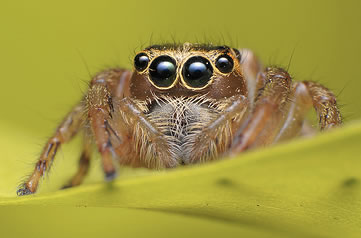 |
As is widely known, spiders construct a web and wait for insects to become trapped. The jumping spider, contrary to others, prefers to go after its prey itself. It makes a nimble leap to reach its prey. It may capture a fly that passes half a metre away from itself in the air by leaping upon it.
The spider makes this amazing leap by its eight feet that work on hydraulic pressure principles, and all of a sudden it descends on its prey and inserts it powerful jaws in it. This leap usually takes place in a convoluted environment of plants. The spider must calculate the most appropriate angle for a successful leap, and consider the speed and direction of its prey.
More interesting is how it saves its own life after catching its prey. The insect could possibly die, because when jumping to catch its prey, it launches itself into the air and so it could easily crash down to the ground from the heights (the spider is usually at the top of a tree).
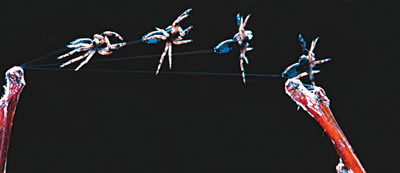 |
The spider, however, does not face such an end. The spider thread, which it had secreted just before jumping and which it sticks on the branch it is on, saves it from falling to the ground and keeps him dangling in the air. This thread is so strong that it can hold both the spider and its prey.
Another interesting feature of this spider is that the poison it injects into its prey liquefies its tissues. The food of the spider is nothing else than the liquefied tissues of its prey.
Certainly, the features of this spider are not gifts (!) of coincidence. It is necessary that it should have gained the skill of both jumping and, at the same time, making a thread that will prevent it from falling. If it could not jump, it would starve and die. If it could not make a thread or if its thread were not strong enough, it would crash to the ground. Then the spider must both have a body structure suitable for jumping and a system to secrete a thread strong enough to lift its prey.
Besides that, the spider is not only a mechanism that produces thread and jumps but a complex living organism and must exist with all its features intact at the same time. The development of none of these features can be deferred. For instance, can you think of a spider with an incomplete digestive system?
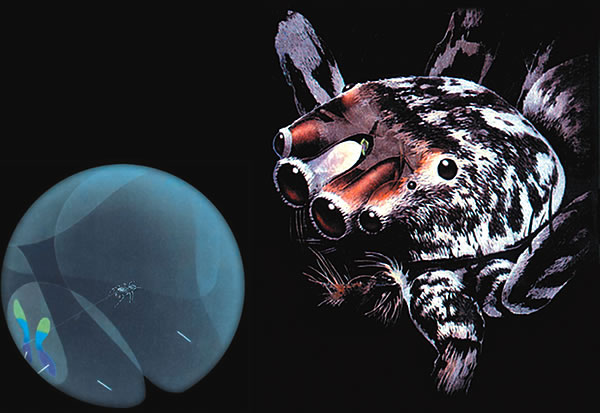 |
It sees 360 degrees aroundAnother extremely interesting feature of the jumping spider is its skill in seeing. Many living organisms, including human beings, can only see a limited space with their two eyes and are unable to see behind them. However, the jumping spider can see everything around itself including its back with its four pairs of eyes located on top of its head. Two of these eyes are extended forward from the middle of the head like test-tubes. These two big eyes (called A.M. eyes) can move from right to left, and up and down in their sockets. The other four eyes on the sides of the head cannot perceive the image completely, yet can detect every movement around them. In this way, the animal can easily identify a prey behind it. |
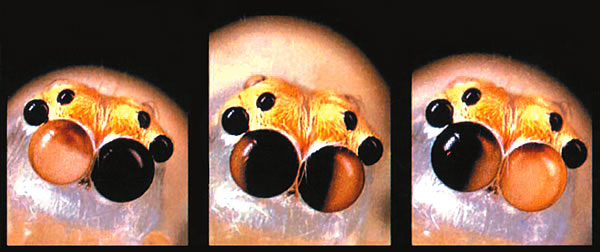 |
| The ability of the jumping spider's eyes to see independently from each other helps the animal perceive objects more rapidly. In the pictures, the dark eye looks at the camera, and the light eye looks elsewhere. It is a wonder that the jumping spider has eight eyes and an angle of vision of 360 degrees whereas other creatures have only two eyes. Certainly, the animal has not, by itself, "thought" that this would be more useful and thus produced additional eyes, or these eyes did not originate coincidentally. The animal has been created by Allah with all these features. |
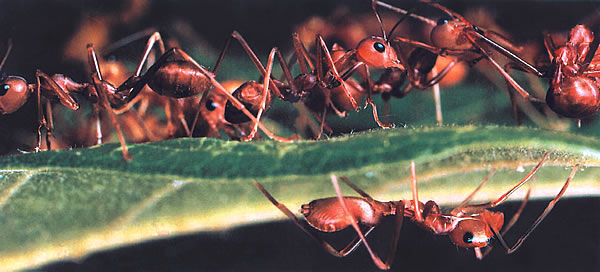 |
If you were asked what you see in the above picture, you would definitely say, "there are some ants above and below the leaf".
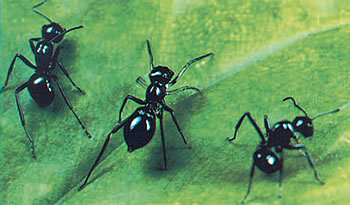 |
| On the left are two ants and a jumping spider. You have no other way but to count the legs to find out which one is the ant and which one is the spider. |
However, what you see under the leaf is a jumping spider lurking to hunt living ants. This species of the jumping spider looks so similar to the ants that even the ants think it is one of them.
The only difference between the ant and the spider is the number of legs. The spider has eight legs whereas the ant has six.
In order to do away with this "handicap", which will make him readily recognised, the jumping spider stretches its two forelegs forward and lifts them up. Thus, its two legs look exactly like the antennae of ants.
Yet, the camouflage does not consist solely of this. The animal needs also an eye pattern that will make it seem like an ant. Its own eyes are not big and in the shape of a dark spot like those of the ants. One feature it possesses by birth helps it solve this problem. The spider has two big spots at the two sides of its head. These two spots resemble the ant's eyes (notice the spots at the sides of the spider’s head in the above picture).
 |
The Water Gun of The Fish |
| This fish shoots the water it has filled in its mouth on insects sitting on branches overhanging the water. The insect falls, due to the pressurised water and becomes an easy prey to the fish. It is worth noting that while launching the attack, the fish does not lift its head out of the water at all, and spots the location of its prey accurately. As is widely known, when viewed from under water, objects outside the water seem, due to the refraction of light, at a different location from where they really are. Therefore, to be able to "hit" a target outside the water from under the water, one needs to know the refractive angle of the light and make the "shot" accordingly. However, this fish innately copes with this difficulty and hits the mark every time. He is Allah - the Creator, the Maker, the Giver of Form. To Him belong the Most Beautiful Names. Everything in the heavens and earth glorifies Him. He is the Almighty, the All-Wise. |
The heat-detectors located in the facial cavities at the anterior of the rattlesnake's head detect the infrared light caused by the body heat of its prey. This detection is so sensitive as to perceive a temperature increase of 1/300 in the heat of the setting. The snake, with the help of its forked-tongue, which is its organ of smell, can sense a motionless red squirrel sitting half a metre away in deep darkness. Fixing the location of its prey faultlessly, the snake first silently sneaks towards it, then comes close enough to attack, arches and stretches its neck and closes upon its target at great speed. By then, it has already inserted the teeth on its strong jaw, which can open to 180 degrees.
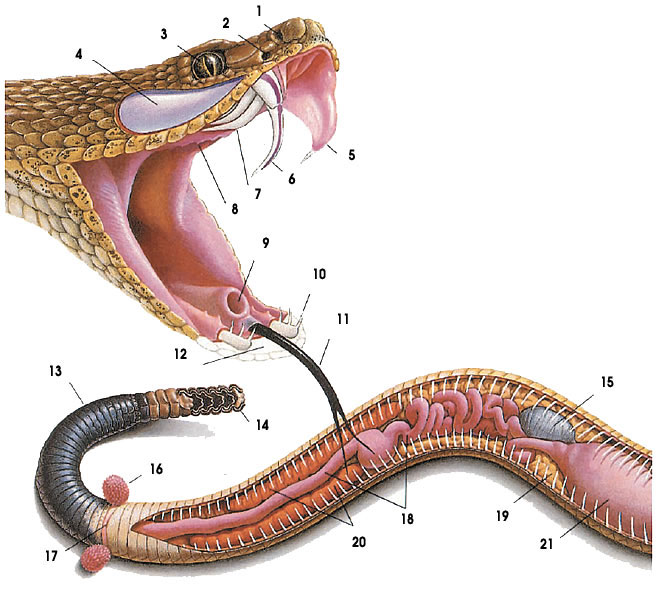 | ||
| 1. Nostrils | 8. Clutching teeth | 15. Gall bladder |
All of this takes place at a speed equivalent to an automobile's accelerating from 0 km/h up to 90 km/h in half a second. The length of the snake's "venomous teeth", its greatest weapon in rendering its victim ineffective, is about 4 cm. The insides of its teeth are hollow and connected to the glands of venom. As soon as the snake bites, the gland’s muscles contract and with great power shoot the poison first into the teeth canal and then under the prey's skin.
 |
| Since snakes do not have jawbones, they can open their mouths as big as they wish. On the left, you may see how a snake can easily eat an egg, which is much larger than it is. The prey is slowly swallowed as a whole and digested. |
The snake venom either paralyses the central nervous system of the prey or causes its death by coagulating the blood. Only 0.028 g of some snakes’ venom is strong enough to kill 125,000 rats. The poison shows its effects so quickly that the prey does not have time to do any harm to the snake. From now on, all that is left to the snake is to engulf its paralysed prey with its highly flexible mouth.
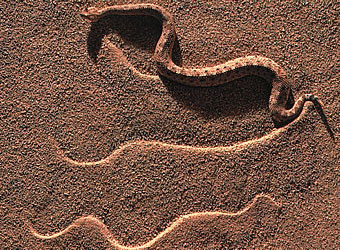 | This desert-dwelling snake can move swiftly on the sand. By contracting its chest muscles by degrees, it moves its body in an S-form. At the beginning of the movement, it twists its body, lifts its head and keeps it poised in the air. As the contraction, which drives the movement, proceeds to the tail, the head moves forward and touches the earth. In the meantime, the motion of contraction has reached the tail. A fresh wave lifts the tail up from the sand and brings it up to the level of the head. Thus, the snake moves forward by leaving parallel traces with a slope of 45 degrees on average. Throughout this movement, only two parts of the snake touch the sand. With this form of movement, the snake's body is protected from being scorched by making minimal contact with the extremely hot, burning sand. |
Though everyone knows the poisonous feature of snakes, almost no one thinks about how this takes place. In fact, an animal’s possessing a technology to kill another animal by poison is quite astonishing and extraordinary. Those who insist on denying the existence of Allah are certainly incapable of explaining how snakes possess such an extraordinary skill. The venomous system in the mouth of the snake is a very complex and sophisticated one. In order for this system to function, the snake has to have special "venomous teeth", which are hollow inside, and venomous glands connected to these teeth. A very powerful venom that will paralyse its enemies has to have been formed, and this reflex has to work as soon as the animal bites its prey. This multi-component system would not work with one of its components missing. That would result in the snake’s falling prey to the animals it has chosen to hunt. The extraordinary skills of the animal in sensing temperature change and odour show the detailed nature of the design we are facing.
Here, there is an extraordinary and unusual occurrence that we can only term a "miracle". It is, however, out of the question that nature could create a miracle which is "supernatural". Nature is a name given to the entire order we see around us. The founder of this order can surely not be the order itself. The laws of nature are those laws Allah fixed, which set the relationships among those that He created. Defining concepts properly reveals the truth. Confusing concepts, on the other hand, is a characteristic of the unbelievers. They do it to conceal the facts and deny the crystal-clear creation.
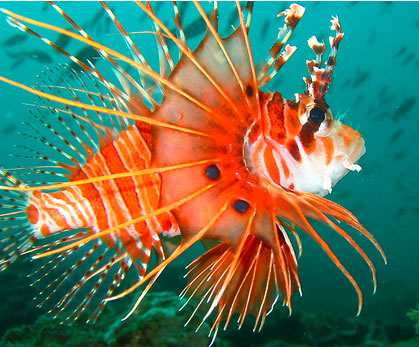 | Lion FishAfter trapping smaller fish in cave-like or rocky shelters, this dazzlingly coloured fish closes their exits by using its fins as a net. Those fish that try to flee face the poisonous spines of the lion fish. The powerful venom of the lion fish takes instant effect and causes the deaths of its victims. |
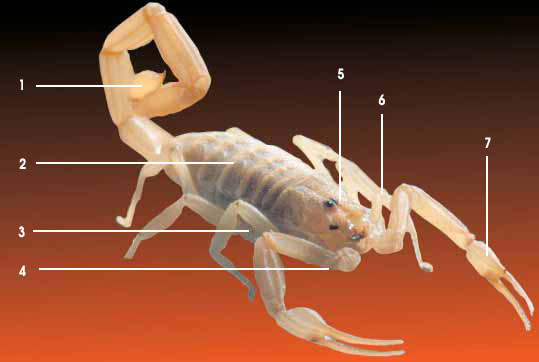 | |
War Machine: The Scorpion1.Poisonous sting 2. A robust armour 3. Lungs 4. Abdomen 5. Brain 6. Feet 7. Pincers |
 |
Hook FishWhen this fish needs to hunt, it sets free the appendage coming out from its head like a hook and begins to wait. The other fish that approach this extension, thinking that it is a small fish, cannot escape falling a prey to the sudden attack of the hunter fish.We all know that a fish has no means to create a hook in its own body, and that such an issue cannot be side-stepped by a senseless explanation such as "it just happened to be so by coincidence". |
 |
| It brings bait for the fish. |
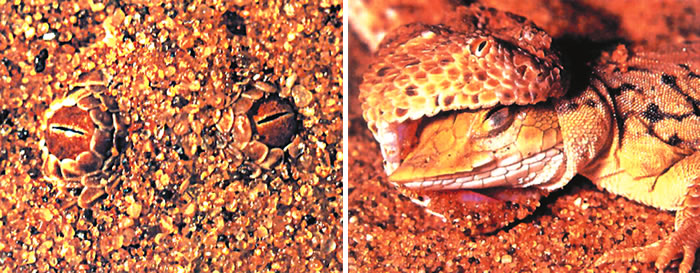 |
| With their outward appearance being quite suitable for camouflage, some animals have a great advantage in hunting. For instance, it is impossible to notice the snake above when hidden under the sand. For this snake waiting in ambush, it is quite easy to hunt its prey, which comes right under its nose without realising it. |
 |
| Another animal endowed with the ability of camouflage is a fish named "the stargazer". This fish hides itself under the sand on the seafloor. Over the mouth of the fish is a tooth-like fringed structure. It comfortably breathes under the sand via this organ, which looks like a tooth and can hardly be distinguished from sand. It waits in ambush for its prey and once it comes close, it rushes out from under the sand and catches it. |
A Master Hunter: Chameleon |
 |
Tongue:The chameleon's tongue is kept collapsed within its mouth like an accordion. In the middle of its tongue is a sharp-ended cartilage. When the circular muscles at the tip of its tongue contract, the tongue shoots out. The animal's tongue is covered with a mucous-like viscous liquid. When it approaches close enough to its prey, it opens its mouth and rapidly hurls its tongue towards its victim. The viscous tongue, owing to the intertwining muscles, reaches as far as 1.5 times the length of the chameleon. The time for the tongue to retrieve the prey and retract is only 0.1 seconds. |
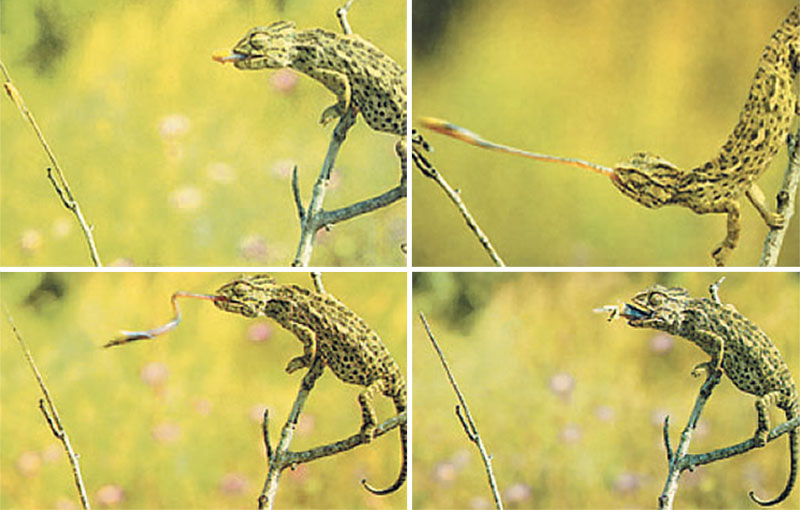 |
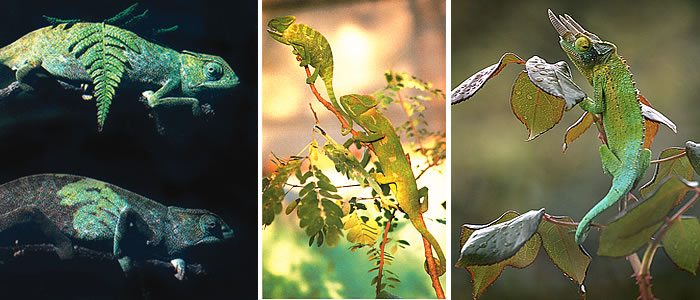 |
Camouflage:The chameleon is certainly the first animal that comes to the mind when camouflage is raised. The chameleon changes its colour according to the ground on which it stands. To the left can be seen the mark made on the coat of the chameleon by the fern left on its back. Light and temperature changes are considered to have a role in the reactions that cause this mark. Yet, the animal is not even aware of its advantageous skill in changing colours. Its body is originally created to automatically match the colours of its surroundings. |
 |
| This tiger which is perfectly camouflaged, with its agility, powerful jaw, claws, speed and strength, is the perfect hunter. Another characteristic of the tiger is that it never allows the wind to be at its back while tracing its prey, since the wind blowing from behind it would carry its odour to its prey and hence cause it to be noticed. |
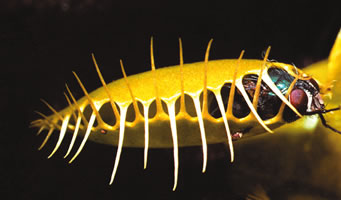 |
Besides the predators we have mentioned so far, there are also some plants which "hunt" by using amazing methods. One of these is the "Venus" plant, which catches and feeds on insects that visit it.
The hunting system of this plant works as follows: a fly looking for food among the plants suddenly comes across one which is very attractive: the Venus plant. What makes this plant, which resembles a pair of hands holding a bowl, attractive, is its charming red colour and, more importantly, the sweet scent secreted by the glands surrounding its petals. The fly is charmed by this irresistible smell and lands on the plant without hesitation. While moving towards the origin of the food, it inevitably touches the seemingly harmless hair over the plant. After a short while, the plant suddenly snaps its petals shut. The fly is left tightly compressed between two petals. The Venus plant starts to secrete a "flesh dissolving" liquid, which causes the fly to turn into a jelly-like substance, and then the plant consumes the fly by absorbing it.
The swiftness of the plant in catching the fly is remarkable. The speed of the plant in closing is faster than the fastest closing speed of the hands of a human (if you try to catch a fly sitting on your palm, you most probably would not succeed, but the plant does). How, then, can this plant, which has no muscles or bones, make such an abrupt move?
Research has shown that there exists an electrical system inside the Venus plant. The system works as follows: the strokes of the fly on the hairs of the plant are transmitted to the receptors under the hairs. If this mechanical push is strong enough, these receptors will send electrical signals along the petal, just like waves in a pool. These signals are carried to the motor cells that cause the petals to make sudden moves, and finally the mechanism is activated to swallow the fly.
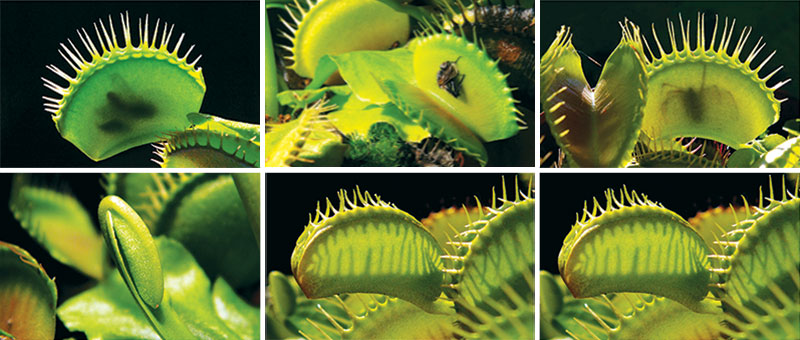 |
| A few hairs inside the petals of the plant activate the trapping mechanism of the flower. |
In addition to the stimulus system of the plant, the mechanical system by which the trap is closed also is created perfectly. As soon as the cells inside the plant receive electrical stimulation, they change the concentration of water within themselves. The cells inside the trap release water from their bodies. This event is like the dying of a deflated balloon. The cells outside the trap, on the other hand, take in excess water and swell. Thus, the trap is closed in the same way as when a person, in order to move his arm, needs to have one muscle contract and one relax. The fly trapped inside the plant actually touches the hairy strands repeatedly, causing the propulsive electrical force to discharge again, and making the trap more tightly closed. Meanwhile, the digestive glands in the trap are also activated. As a result of stimulation, these glands kill the insect and start slowly dissolving it. Thus, the plant feeds on digestive fluids that have turned into a bowl of soup enriched by plant proteins. At the end of the digestion, the mechanism that makes the trap close works conversely to open it.
 |
| 1. The fly makes the hairs vibrate and the reaction starts. |
This system has yet another interesting feature: in order to activate the trap, the hairs have to be touched twice in succession. The first touch generates a static electric charge but the trap is not closed. The trap is only closed with a second touch after the static charge reaches a certain point and discharges. Due to this dual action mechanism, the flytrap is never closed without purpose. For instance, the trap does not become activated as soon as a raindrop falls on it.
Now, let us contemplate this striking system. The whole system has to exist at the same time for the plant to catch its prey and digest it properly. The absence of only one element would mean death for the plant. For instance, if there were no hairs inside the leaf, the plant would not close, as the reaction would never start although the insect would walk all over and inside the plant. If the closing system were there, but if the plant were devoid of secretions to digest the insect, the whole system would be useless. In brief, any element lacking in the system would mean the death of the plant.
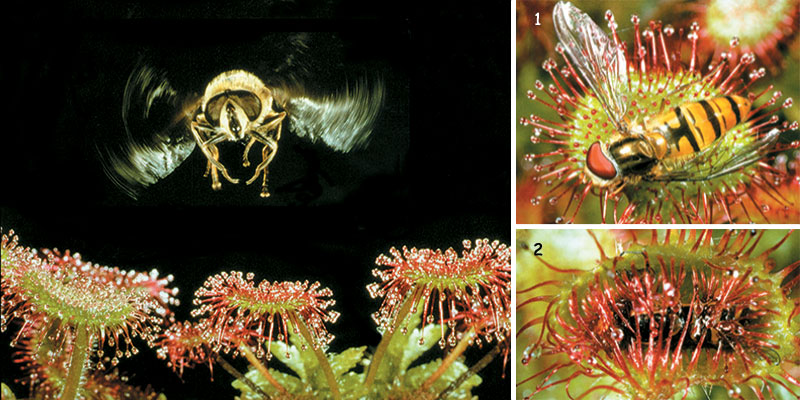 |
Hairs of SundewThe petals of this plant are covered with long, red hairs. The tips of these hairs are coated with a liquid, which has a special scent that attracts insects. Another feature of this liquid is viscosity. An insect that aims at the origin of the smell will become stuck in these viscous hairs. As the insect struggles to escape, these tendrils start to bend down to better grip the insect. The insect, which is fully arrested, is digested in the protein breaking secretion. The active system of the plant is similar to that of the Venus plant. The hairs on its top and stem vibrate, and the electric signals that originate at the bottom start the reaction. |
This plant, since the moment it was created, must have always possessed the features we refer to here. The plant, no doubt, did not suddenly transform into a hunter. It is certainly not the "magical spell of coincidences" that has made the plant such a professional hunter.
The most important point is that this proficient hunter does not have the capacity to think. If this living being were not a plant but an animal, then the advocates of evolution would possibly claim that the animal had progressed by itself with the estimable contributions (!) of "nature". What we are talking about here is that this system is found in a plant, a being with no brain or similar structure, and which is certainly unconscious. The plant is not even aware that it is hunting. It, too, is already created with a system by which it can feed itself without any effort just like all other plants.
 |
| Allah is the Creator of everything and |